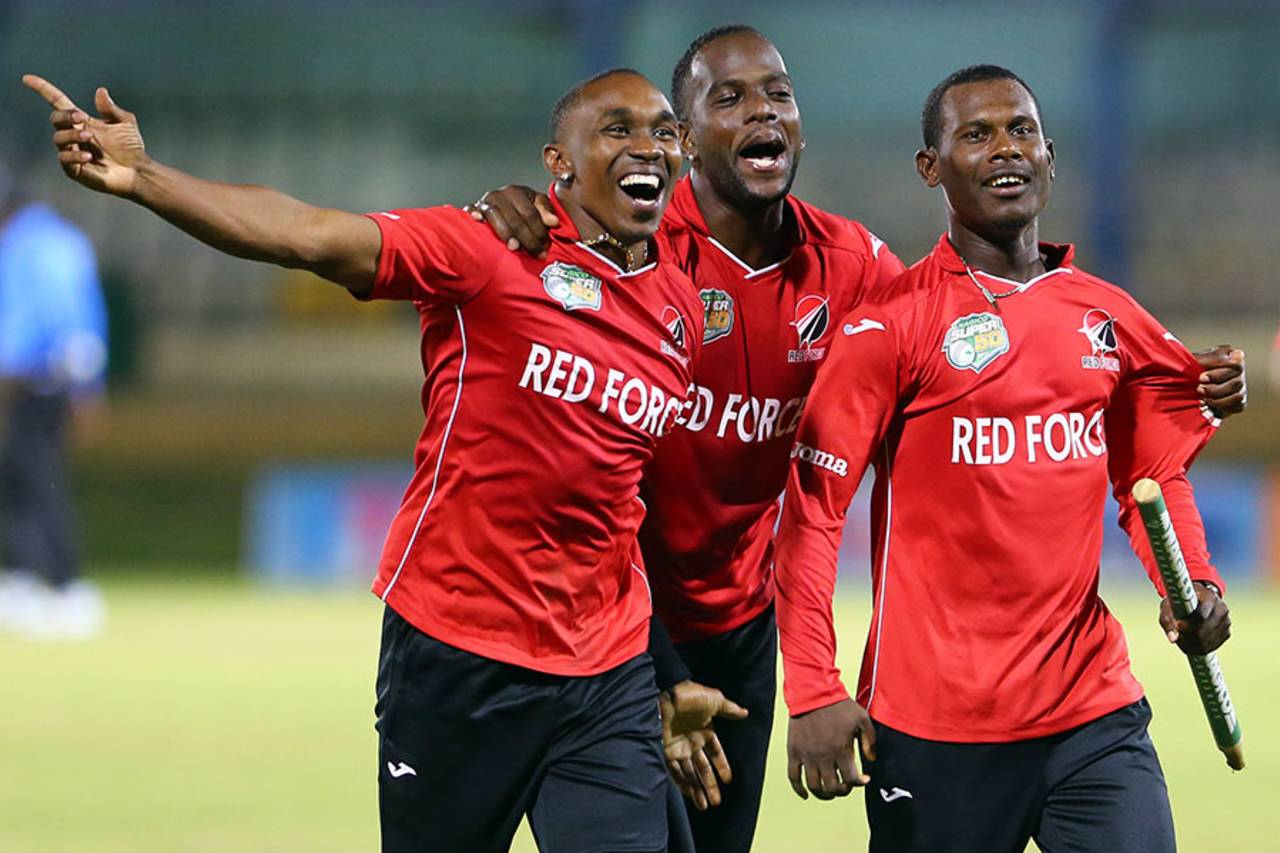Why a strong T&T could bode well for West Indies
If the team can carry its limited-overs success into four-day cricket, the effect on West Indies' Test fortunes can only be positive
Colin Benjamin
09-Feb-2015

T&T have been giants in T20 cricket but they haven't been as successful in the four-day game in recent seasons • WICB
Two characteristics noticeable in the legendary West Indies cricket teams of the post-World War II era were depth and the dominance of one territory, which usually provided the core of the region's first XI. The first great West Indies team, from about 1963 to 1968 had a strong Barbadian influence, was captained by the legendary Frank Worrell and Garfield Sobers, and included the fast-bowling pair of Wes Hall and Charlie Griffith and key players like Conrad Hunte, Seymour Nurse and allrounder David Holford. Barbados even challenged a World XI in 1967. Not bad for a little island of 166 square miles.
The team of the 1976-to-1995 period alternated between a Barbadian and Antiguan backbone. Gordon Greenidge, Desmond Haynes, Malcolm Marshall and Joel Garner represented Barbados, while Vivian Richards, Curtly Ambrose, Richie Richardson and Andy Roberts came from the latter territory.
Can Trinidad and Tobago's recent Super50 triumph and resurgence in the longer version of the game have a similar impact on West Indies' cricket fortunes? In November 2013, after West Indies were embarrassed in the Sachin Tendulkar farewell series in India, the second vice-president of the Trinidad and Tobago Cricket Board, Lalman Kowlessar, stated that "only T&T can rescue West Indies cricket".
"The revival of West Indies cricket may well depend on Trinidad and Tobago's ability to churn out quality players in the Test match arena much as they have done in the T20 game," he said. One might say that Kowlessar was just being insular in hyping the credentials of his native Trinidad, but a deeper analysis of Kowlessar's assessment shows it is clear he might be correct.
A hypothetical best Trinidad and Tobago line-up of Evin Lewis, Lendl Simmons, Darren Bravo, Jason Mohammed, Dwayne Bravo, Kieron Pollard, Denesh Ramdin, Rayad Emrit, Sunil Narine, Ravi Rampaul, Samuel Badree - with Nicholas Pooran, Kevon Cooper, Adrian Barath and Shannon Gabriel in the reserves - all realistically should be the heartbeat of the regional team for the foreseeable future in the various formats.
After Trinidad and Tobago ended a 21-year drought with back-to-back four-day titles in the 2005-06 and 2006-07 seasons, many predicted the start of a golden era for the dual-island republic in regional cricket.
But the side's success had been predominately in the domestic one-day and T20 competitions, where they won four of six (T20) tournaments before the Caribbean Premier League was launched, and they made the region proud in the Champions League T20. But before last month's triumph, they had not won a 50-over title since 2009-10, regularly falling short when they were hot favourites. It's no coincidence that eight of the victorious 15-member squad for the 2012 World T20 hailed from Trinidad.
Regardless of that global triumph, true respect in the game still comes from the state of your Test team, and it is in this arena that West Indies must catch up.
Jamaica have been best at exploiting the mediocrity of its opponents in the four-day game, rather than being a great team in their own right. The performances of Tamar Lambert and Nikita Miller suggest as much
Carla Rauseo, writing for the Trinidad Guardian in March 2013, provided an interesting theory on why Trinidad and Tobago, and by extension the West Indies team, now excel in T20 cricket: "Simply, we excel in T20 cricket because the characteristics of the game reflect the qualities of our society."
Jamaica have been the big dog in the first-class competition in recent years, bagging five of the last seven titles, dating back to 2007-08. And curiously, Jamaica have achieved all this with minimal input from their most high-profile players - the likes of Chris Gayle, Marlon Samuels and Jerome Taylor. But why has this island's dominance failed to noticeably benefit West Indies?
In the last two decades of Caribbean cricket, a decline in the standard of the domestic first-class scene has coincided with the regional team's weakness in the international arena. Jamaica, in my view, has been best at exploiting the mediocrity of their opponents in the four-day game, rather than being a great team in their own right. The performances of two of their key players, captain Tamar Lambert and spinner Nikita Miller, suggest as much.
Lambert is regularly praised as the best captain in regional cricket, but he averages less than 30 with the bat in first-class cricket and was never seriously considered for the West Indies captaincy. It is not a batting record that would recommend anyone for the international stage. Miller, on the other hand, just might have the best domestic average for a spinner in any domestic first-class competition worldwide, with a staggering 16.87 runs conceded for his 338 victims. On stats alone, he looks like Alf Valentine reincarnated.
Caribbean batsmen are appalling at playing spin and Miller thrived with the aid of little more than nagging accuracy. But at the international level, the top batsmen are not troubled by a spinner who does not turn the ball significantly, and as such, Narine and Shane Shillingford have proved to be better picks for West Indies.
In an effort to improve West Indies' Test match fortunes, this season the board implemented the professional league structure in the first-class system, with two rounds of four-day matches. While this is long overdue and the well publicised problems ailing the region's cricket can't be fixed overnight, perhaps in the short term Trinidad and Tobago dominating in the longer format could have an immediate effect on West Indies' Test results.